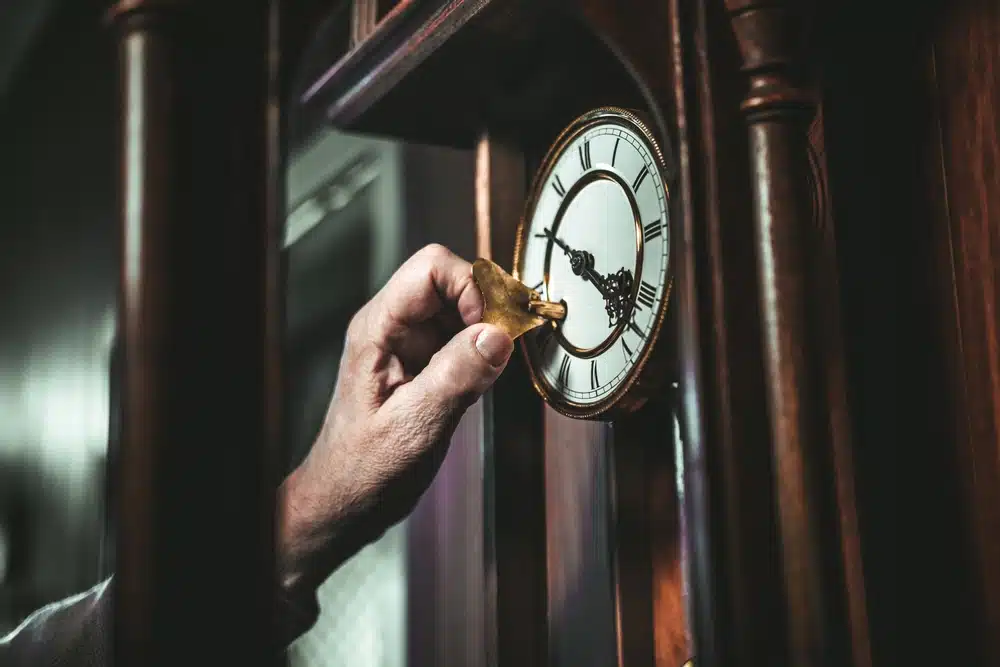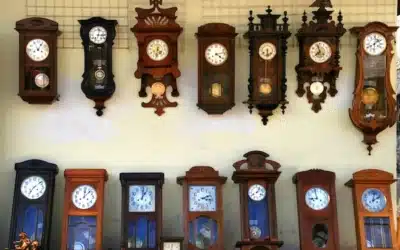Decorative and practical, grandfather clocks are true time capsules from the past. They may connect you to past generations with every tick and chime, but let’s be real, they’re pretty finicky. All those gears and springs inside need extra care, so proper storage is a slightly bigger deal than with other timepieces.
Whether you’re holding onto a grandfather clock for the sentimental value or just because it’s a stunner, this guide ill walk you through the dos and don’ts of grandfather clock storage when it’s time to retire the piece from the spotlight, even if only temporarily.
Understanding Your Grandfather Clock

credit: Shutterstock / 2292519223
Before moving your grandfather clock into a storage unit, you’re going to first disassemble it. To help you familiarize yourself with your specific clock’s parts before you get to that step, here’s a brief and informative guide to its key components:
| Clock part | Where | Details |
| Case (Cabinet) | Outer structure | Typically made of wood or metal, it houses all the internal components of the clock. |
| Hood or Bonnet | Top part of the clock | Crown: Often decorative, like a split pediment with a center finial or a flat top. Face: The area that displays the time with hands and often ornamental designs. |
| Waist (Trunk) | Middle section | It houses the clock’s driving mechanisms: Pendulum: A swinging weight that regulates timekeeping. Weights: Usually three, each serving different functions (chiming, striking and running the clock). |
| Base | Lower section | May include adjustable feet for leveling. |
What Comes Before Grandfather Clock Storage? Disassembly
With all the grandfather clock parts noted, it’s time to move on to the actual disassembly process. But first, allow the clock to wind down for three days.
1. Prepare for disassembly
Gather all the tools and packing materials you’ll need and clear out a good-sized area to work in — you want enough room to move around freely without bumping into anything. Tools to put on your list include screwdrivers, cotton gloves for a good grip with no fingerprints, plenty of bubble wrap, moving blankets and tape to keep things safe.
2. Take apart the pendulum
Gently stop the pendulum by catching it mid-swing — be smooth and steady here. Once it’s stopped, carefully unhook it. Remember, this part can be quite weighty and a bit awkward to handle.
3. Remove the weights
Ease those weights down and support them as they come off — they can be surprisingly heavy. Grip them firmly with your gloves on, as there may be some sharp edges or oily surfaces.
Then, wrap each weight individually in bubble wrap or a blanket to avoid dings or scratches during moving. If you opt for bubble wrap, remember to remove it after transport. Any plastic cover in storage can trap harmful moisture.
Pro tip: To keep track of everything, slap a label on it noting its position. You’ll want to place those weights in the right spots when storage nap time is over. Taking photos of each step with your phone can also help aid your memory when it is time to put it all together again.
4. Tackle the finials
If your clock has fancy finials up top, carefully unscrew them or gently lift them off as they are often loose. These bits are usually pretty intricate and fragile, so handle them with care.
5. Protect the case
Once everything’s stripped down, drape the clock case in a dust cover or a moving blanket to keep it from getting scratched up or dusty.
Make sure the case won’t tip over or get shuffled around. It’s going to be a bit lighter now, so it might be more prone to accidents.
Pro tip: If you want to check the clock mechanism before putting the piece in storage, take off the hood while all the weights and the pendulum are still in the case, as they stabilize the grandfather clock. Gently jiggle the hood a bit so that it slides forward, but when doing that, lock the glass door or hold it closed with your thumb if it doesn’t lock.
Grandfather Clock Storage (and Packing) Tips
First, start with the best packing materials you can find. Bubble wrap and moving blankets are your best friends for moving because they soak up any bumps and knocks. But for long-term storage, think about using acid-free tissue or cloth wraps instead. These don’t trap moisture like plastic does, and moisture is one of the worst enemies clocks have.
- Always store your grandfather clock standing up, as laying it down can put weird pressure on its insides.
- Make sure things like chimes and glass panels are snug and won’t move before you start moving the clock.
- When storing the pendulum separately, try to keep it upright as well. Maybe rig up a special stand or find a padded box that fits just right. Keeping it vertical helps make sure it doesn’t get bent out of shape or messed up while it waits for its next tick.
- Each weight should get its own wrap of soft cloth or bubble wrap, especially for the move. When you store them, put each one in its own sturdy box, padded well so they don’t move around and get dinged up.
- Throw a breathable cloth over the case to keep the dust off without trapping moisture.
Pro tip: Grandfather clock moving is no easy task. For long-term storage or relocation, you should consult professional movers who have experience handling grandfather clocks.
Another thing experts recommend is to find a climate-controlled spot for the clock case. Extreme temperatures and humidity are real trouble for wood and metal. Trouble that clocks cannot recover from.
Reassembling a Grandfather Clock after Storage
If you followed the guidelines for disassembling and packing the grandfather clock parts, reassembly should go smoothly. It may not be exactly a breeze without the hands and eyes of a pro on the job, but still pretty straightforward.
Step 1. Place the clock case in its new spot — you won’t want to move it again after you get all the parts in.
Step 2. Reattach the pendulum and the weights. Those labels you made when you disassembled the clock are going to be super helpful here. Follow them closely to make sure everything goes back in the right place.
Step 3. Give the pendulum a gentle push to start it swinging and bring your clock back to life.
Step 4. Move only the minute hand slowly counterclockwise to set the time.
Step 5. Let the clock run for a few hours. Pay attention to the ticking and chiming. Everything should sound regular and consistent.
Step 6. If the clock seems off pace, adjust the pendulum. Turn the nut at the bottom of the pendulum rod to tweak the timing. Clock running too fast? Turn it counterclockwise. Too slow? Clockwise is the way to go.
If any of this feels overwhelming and the owner’s manual doesn’t help as much as you hoped, don’t hesitate to call in a professional to get it going smoothly again.
Mastering Grandfather Clock Storage
Whether your grandfather clock is taking a timeout in storage or getting ready to shine in your new home, you should now have everything straight.
Grab high-quality materials for the long haul, keep your clock upright all the way and label everything like a boss. To keep it cool and consistent for many years to come, opt for a climate-controlled unit — fluctuating temps and humidity are the archenemies of fine craftsmanship, that’s for sure.
This timeless piece deserves the best care, so here’s to making sure it keeps turning heads and telling time for years to come.


